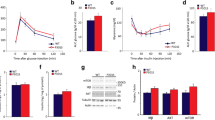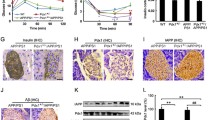Abstract
Background
Epidemiological evidence has demonstrated a clear association between diabetes mellitus and increased risk of Alzheimer’s disease (AD). Cerebral accumulation of phosphorylated tau aggregates, a cardinal neuropathological feature of AD, is associated with neurodegeneration and cognitive decline. Clinical and experimental studies indicate that diabetes mellitus affects the development of tau pathology; however, the underlying molecular mechanisms remain unknown.
Objective
In the present study, we used a unique diabetic AD mouse model to investigate the changes in tau phosphorylation patterns occurring in the diabetic brain.
Design
Tau-transgenic mice were fed a high-fat diet (n = 24) to model diabetes mellitus. These mice developed prominent obesity, severe insulin resistance, and mild hyperglycemia, which led to early-onset neurodegeneration and behavioral impairment associated with the accumulation of hyperphosphorylated tau aggregates.
Results
Comprehensive phosphoproteomic analysis revealed a unique tau phosphorylation signature in the brains of mice with diabetic AD. Bioinformatic analysis of the phosphoproteomics data revealed putative tau-related kinases and cell signaling pathways involved in the interaction between diabetes mellitus and AD.
Conclusion
These findings offer potential novel targets that can be used to develop tau-based therapies and biomarkers for use in AD.





Similar content being viewed by others
References
Livingston G, Sommerlad A, Orgeta V, et al. Dementia prevention, intervention, and care. Lancet 2017;390:2673–2734. https://doi.org/10.1016/S0140-6736(17)31363-6
Takeda S, Sato N, Rakugi H, Morishita R. Molecular mechanisms linking diabetes mellitus and Alzheimer disease: beta-amyloid peptide, insulin signaling, and neuronal function. Mol Biosyst 2011;7:1822–1827. https://doi.org/10.1039/c0mb00302f
Takeda S, Sato N, Uchio-Yamada K, et al. Diabetes-accelerated memory dysfunction via cerebrovascular inflammation and Abeta deposition in an Alzheimer mouse model with diabetes. Proc Natl Acad Sci U S A 2010;107:7036–7041. https://doi.org/10.1073/pnas.1000645107
Takeda S, Rakugi H, Morishita R. Roles of vascular risk factors in the pathogenesis of dementia. Hypertens Res 2020;43:162–167. https://doi.org/10.1038/s41440-019-0357-9
Ohara T, Doi Y, Ninomiya T, et al. Glucose tolerance status and risk of dementia in the community: the Hisayama study. Neurology 2011;77:1126–1134. https://doi.org/10.1212/WNL.0b013e31822f0435
Ott A, Stolk RP, van Harskamp F, Pols HA, Hofman A, Breteler MM. Diabetes mellitus and the risk of dementia: the Rotterdam Study. Neurology 1999;53:1937–1942. https://doi.org/10.1212/wnl.53.9.1937
Ballard C, Gauthier S, Corbett A, Brayne C, Aarsland D, Jones E. Alzheimer’s disease. Lancet 2011;377:1019–1031. https://doi.org/10.1016/S0140-6736(10)61349-9
Grundke-Iqbal I, Iqbal K, Quinlan M, Tung YC, Zaidi MS, Wisniewski HM. Microtubule-associated protein tau. A component of Alzheimer paired helical filaments. J Biol Chem 1986;261:6084–6089.
Gómez-Isla T, Hollister R, West H, et al. Neuronal loss correlates with but exceeds neurofibrillary tangles in Alzheimer’s disease. Ann Neurol 1997;41:17–24. https://doi.org/10.1002/ana.410410106
Martin L, Latypova X, Wilson CM, et al. Tau protein kinases: involvement in Alzheimer’s disease. Ageing Res Rev 2013;12:289–309. https://doi.org/10.1016/j.arr.2012.06.003
Alonso A, Zaidi T, Novak M, Grundke-Iqbal I, Iqbal K. Hyperphosphorylation induces self-assembly of tau into tangles of paired helical filaments/straight filaments. Proc Natl Acad Sci U S A 2001;98:6923–6928. https://doi.org/10.1073/pnas.121119298
Trojanowski JQ, Lee VM. Paired helical filament tau in Alzheimer’s disease. The kinase connection. Am J Pathol 1994;144:449–453.
Clodfelder-Miller BJ, Zmijewska AA, Johnson GV, Jope RS. Tau is hyperphosphorylated at multiple sites in mouse brain in vivo after streptozotocin-induced insulin deficiency. Diabetes 2006;55:3320–3325. https://doi.org/10.2337/db06-0485
Leboucher A, Laurent C, Fernandez-Gomez FJ, et al. Detrimental effects of diet-induced obesity on τ pathology are independent of insulin resistance in τ transgenic mice. Diabetes 2013;62:1681–1688. https://doi.org/10.2337/db12-0866
Nobuhara CK, DeVos SL, Commins C, et al. Tau antibody targeting pathological species blocks neuronal uptake and interneuron propagation of tau in vitro. Am J Pathol 2017;187:1399–1412. https://doi.org/10.1016/j.ajpath.2017.01.022
Wesseling H, Mair W, Kumar M, et al. Tau PTM profiles identify patient heterogeneity and stages of Alzheimer’s disease. Cell 2020;183:1699–1713.e13. https://doi.org/10.1016/j.cell.2020.10.029
Yoshiyama Y, Higuchi M, Zhang B, et al. Synapse loss and microglial activation precede tangles in a P301S tauopathy mouse model. Neuron 2007;53:337–351. https://doi.org/10.1016/j.neuron.2007.01.010
Ayala JE, Samuel VT, Morton GJ, et al. Standard operating procedures for describing and performing metabolic tests of glucose homeostasis in mice. Dis Model Mech 2010;3:525–534. https://doi.org/10.1242/dmm.006239
Guyenet SJ, Furrer SA, Damian VM, Baughan TD, La Spada AR, Garden GA. A simple composite phenotype scoring system for evaluating mouse models of cerebellar ataxia. J Vis Exp 2010;39:1787. https://doi.org/10.3791/1787
Lei P, Ayton S, Moon S, et al. Motor and cognitive deficits in aged tau knockout mice in two background strains. Mol Neurodegener 2014;9:29. https://doi.org/10.1186/1750-1326-9-29
Kawashima Y, Watanabe E, Umeyama T, et al. Optimization of data-independent acquisition mass spectrometry for deep and highly sensitive proteomic analysis. Int J Mol Sci 2019;20:5932. https://doi.org/10.3390/ijms20235932
Searle BC, Pino LK, Egertson JD, et al. Chromatogram libraries improve peptide detection and quantification by data independent acquisition mass spectrometry. Nat Commun 2018;9:5128. https://doi.org/10.1038/s41467-018-07454-w
Sato H, Ishida S, Toda K, et al. New approaches to mechanism analysis for drug discovery using DNA microarray data combined with KeyMolnet. Curr Drug Discov Technol 2005;2:89–98. https://doi.org/10.2174/1570163054064701
Satoh J, Tabunoki H, Arima K. Molecular network analysis suggests aberrant CREB-mediated gene regulation in the Alzheimer disease hippocampus. Dis Markers 2009;27:239–252. https://doi.org/10.3233/DMA-2009-0670
Takeda S. Tau propagation as a diagnostic and therapeutic target for dementia: potentials and unanswered questions. Front Neurosci 2019;13:1274. https://doi.org/10.3389/fnins.2019.01274
Takeda S, Wegmann S, Cho H, et al. Neuronal uptake and propagation of a rare phosphorylated high-molecular-weight tau derived from Alzheimer’s disease brain. Nat Commun 2015;6:8490. https://doi.org/10.1038/ncomms9490
Götz J, Chen F, van Dorpe J, Nitsch RM. Formation of neurofibrillary tangles in P301l tau transgenic mice induced by Abeta 42 fibrils. Science 2001;293:1491–1495. https://doi.org/10.1126/science.1062097
Barthélemy NR, Li Y, Joseph-Mathurin N, et al. A soluble phosphorylated tau signature links tau, amyloid and the evolution of stages of dominantly inherited Alzheimer’s disease. Nat Med 2020;26:398–407. https://doi.org/10.1038/s41591-020-0781-z
Brandt R, Léger J, Lee G. Interaction of tau with the neural plasma membrane mediated by tau’s amino-terminal projection domain. J Cell Biol 1995;131:1327–1340. https://doi.org/10.1083/jcb.131.5.1327
Brandt R, Trushina NI, Bakota L. Much more than a cytoskeletal protein: physiological and pathological functions of the non-microtubule binding region of tau. Front Neurol 2020;11:590059. https://doi.org/10.3389/fneur.2020.590059
Li T, Paudel HK. Glycogen synthase kinase 3beta phosphorylates Alzheimer’s disease-specific Ser396 of microtubule-associated protein tau by a sequential mechanism. Biochemistry 2006;45:3125–3133. https://doi.org/10.1021/bi051634r
Zhou XW, Winblad B, Guan Z, Pei JJ. Interactions between glycogen synthase kinase 3beta, protein kinase B, and protein phosphatase 2A in tau phosphorylation in mouse N2a neuroblastoma cells. J Alzheimers Dis 2009;17:929–937. https://doi.org/10.3233/JAD-2009-1113
Zheng-Fischhöfer Q, Biernat J, Mandelkow EM, Illenberger S, Godemann R, Mandelkow E. Sequential phosphorylation of Tau by glycogen synthase kinase-3beta and protein kinase A at Thr212 and Ser214 generates the Alzheimer-specific epitope of antibody AT100 and requires a paired-helical-filament-like conformation. Eur J Biochem 1998;252:542–552. https://doi.org/10.1046/j.1432-1327.1998.2520542.x
Yoshimura Y, Ichinose T, Yamauchi T. Phosphorylation of Tau protein to sites found in Alzheimer’s disease brain is catalyzed by Ca2+/calmodulin-dependent protein kinase II as demonstrated tandem mass spectrometry. Neurosci Lett 2003;353:185–188. https://doi.org/10.1016/j.neulet.2003.09.037
Xu J, Sato S, Okuyama S, et al. Tau-tubulin kinase 1 enhances prefibrillar tau aggregation and motor neuron degeneration in P301L FTDP-17 tau-mutant mice. FASEB J 2010;24:2904–2915. https://doi.org/10.1096/fj.09-150144
Taniguchi T, Kawamata T, Mukai H, et al. Phosphorylation of tau is regulated by PKN. J Biol Chem 2001;276:10025–10031. https://doi.org/10.1074/jbc.M007427200
Tavares IA, Touma D, Lynham S, et al. Prostate-derived sterile 20-like kinases (PSKs/TAOKs) phosphorylate Tau protein and are activated in tangle-bearing neurons in Alzheimer disease. J Biol Chem 2013;288:15418–15429. https://doi.org/10.1074/jbc.M112.448183
Propson NE, Roy ER, Litvinchuk A, Köhl J, Zheng H. Endothelial C3a receptor mediates vascular inflammation and blood-brain barrier permeability during aging. J Clin Invest 2021;131:e140966. https://doi.org/10.1172/JCI140966
Acknowledgments
This study was supported by Center for Medical Research and Education, Graduate School of Medicine, Osaka University. This work was supported by the Japan Society for the Promotion of Science (JSPS) KAKENHI grants, including a Grant-in-Aid for Young Scientists (A) (17H05080) and a Grant-in-Aid for Scientific Research (B) (21H02828) awarded to S.T., and a research grant from the Cell Science Research Foundation awarded to S.T.
Funding
The sponsors had no role in the design and conduct of the study; in the collection, analysis, and interpretation of data; in the preparation of the manuscript; or in the review or approval of the manuscript.
Author information
Authors and Affiliations
Corresponding authors
Ethics declarations
Conflict of Interest Statement: The authors declare no conflicts of interest.
Ethical standards: All animal procedures were performed in Osaka University School of Medicine after the approval of the study protocol by the Animal Experiments Committee of Osaka University, Osaka, Japan (decision reference number 29-046-015). This study protocol was reviewed and approved by the Osaka University Living Modified Organisms (LMO) Research Safety Committee (approval number 04232). All animal experiments comply with the ARRIVE guidelines and were carried out in accordance with the National Institutes of Health Guide for the Care and Use of Laboratory Animals.
Electronic Supplementary Material
42414_2023_255_MOESM1_ESM.docx
Supplemental Information: High-fat diet-induced diabetic conditions exacerbate cognitive impairment in a mouse model of Alzheimer’s disease via a specific tau phosphorylation pattern



Rights and permissions
About this article
Cite this article
Ito, Y., Takeda, S., Nakajima, T. et al. High-Fat Diet-Induced Diabetic Conditions Exacerbate Cognitive Impairment in a Mouse Model of Alzheimer’s Disease Via a Specific Tau Phosphorylation Pattern. J Prev Alzheimers Dis 11, 138–148 (2024). https://doi.org/10.14283/jpad.2023.85
Received:
Accepted:
Published:
Issue Date:
DOI: https://doi.org/10.14283/jpad.2023.85




